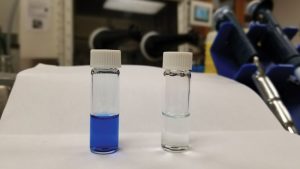
Recent research focused on using polymer to clear dyes from wastewater
By Laura Oleniacz
North Carolina State University researchers have demonstrated that a synthetic polymer can remove certain dyes from water, and that the polymer can be recovered and reused. The findings offer a new potential method for cleaning wastewater after use by textiles, cosmetics or other industries.
“Dyes are used everywhere, including in the textile industry, as well as in pharmaceuticals, cosmetics, paper, leather and even in medicines,” said Januka Budhathoki-Uprety, lead author of a paper on the work and an assistant professor of textile engineering, chemistry and science at NC State, Raleigh, N.C. “If these contaminants aren’t properly removed from wastewater after dyeing and finishing, they can be a significant source of environmental pollution and pose risks for human health.”
In the study, published in ACS Applied Polymer Materials, researchers made a synthetic polymer called polycarbodiimide. The researchers then tested the material’s ability to clean wastewater first by dissolving it in a solvent, and then mixing it with water contaminated with dyes. They tested the polymer solution against a series of 20 anionic dyes, also called acid dyes, which are used in the textile industry. For initial assessments, the researchers did a visual test with the naked eye to see if the polymer worked. The researchers later quantified how well the polymer removed the colorant using ultraviolet-visible (UV-Vis) spectroscopy.
“We mixed the polymer solution and dye-contaminated water so the polymer in the solution can grab on to the dye,” Budhathoki-Uprety said. “This is a two-phase solution, just like oil and water. The polymer part of the solution grabs onto the dyes. Then we were able to easily separate the clean water from the contaminated solution mixture by draining it out, similar to separation of water from a mixture of oil and water.”
The polymer solution removed all but four of the 20 acid dyes they tested. In addition, they found it was easy to recover the polymer within minutes. They found characteristics of the dyes — related to their molecular structures — that contributed to whether the polymer worked or not.
“We found that the polymer solution can remove dyes from contaminated water, and we can recover the polymer and use it to remove dye from contaminated water again,” Budhathoki-Uprety said.
In future studies, researchers are planning to develop a library of polymers that would have the potential to work with more types of dyes. In addition, they want to develop a more practical mechanism for using polycarbodiimide to clean wastewater.
“We are working to develop materials that can do the same work without having to use the polymer in the solution phase,” Budhathoki-Uprety said. “If you have dye spill, you don’t want to have to use a flammable solution — you want a solid material that is easier to handle.”
The study, “Polycarbodiimide for Textile Dye Removal from Contaminated Water,” was published online in ACS Applied Polymer Materials on July 22, 2022. Co-authors included Meghan Lord, graduate student in Fiber and Polymer Science Program, and Graham Neve and Mike Keating, undergraduate students in the Textile Engineering, Chemistry and Science Department at NC State. The study was funded by the Textile Engineering, Chemistry and Science Department at NC State. Individual researchers were also supported by the Office of Undergraduate Research Federal Work Study Research Assistant Program at NC State.
Editor’s Note: Laura Oleniacz is Public Communications Specialist at NC State News Services.
September/October 2022




